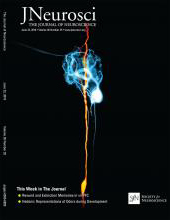- EN - English
- CN - 中文
Extracellular Axon Stimulation
细胞外轴突刺激
发布: 2017年03月05日第7卷第5期 DOI: 10.21769/BioProtoc.2151 浏览次数: 11846
评审: Soyun KimAntoine de MorreeZinan Zhou
Abstract
This is a detailed protocol explaining how to perform extracellular axon stimulations as described in Städele and Stein, 2016. The ability to stimulate and record action potentials is essential to electrophysiological examinations of neuronal function. Extracellular stimulation of axons traveling in fiber bundles (nerves) is a classical technique in brain research and a fundamental tool in neurophysiology (Abbas and Miller, 2004; Barry, 2015; Basser and Roth, 2000; Cogan, 2008). It allows for activating action potentials in individual or multiple axons, controlling their firing frequency, provides information about the speed of neuronal communication, and neuron health and function.
Keywords: Action potentials (动作电位)Background
Extracellular axon stimulation elicits action potentials (APs) without the need of introducing electrodes into neurons. This protocol describes cathodal stimulation, which uses the fact that the membrane potential of a neuron at rest is negative while the extracellular surrounding is positive in comparison. Two electrodes are needed: (1) a stimulation electrode (cathode) placed in close proximity to the axon, and (2) a reference electrode (anode) placed in the bath. When activated, the stimulation electrode adds electrons and thus negative charge to the outside of the axon. This makes the outside of the axon less positive and, as a consequence, decreases the potential difference between inside and outside of the neuron. The result is a local depolarization inside the axon. If sufficient in magnitude, this elicits an AP. The elicited AP originates close to the stimulation electrode and propagates bi-directionally along the axon.
The threshold current needed to elicit APs depends on several parameters, including (1) axon diameter (thicker axons are depolarized first), (2) the distance between stimulation electrode and axon, and (3) stimulation amplitude and duration. The duration must be limited to less than the duration of an AP to prevent the neuronal membrane from becoming refractory. Thus, short current pulses at threshold amplitude are typically used to elicit individual APs. Since thicker axons are recruited at lower stimulus amplitudes, extracellular stimulation works best if the axon of interest is the one with the largest diameter in the nerve. If smaller axons are targeted, larger stimulus amplitudes are required, which may activate larger axons first, in addition to the smaller axons of interest.
Materials and Reagents
Note: The materials and equipment listed refer to the equipment used in Städele and Stein (2016). The principles of retrograde extracellular axon stimulations are universal and the procedures can be easily adapted to other preparations. To reduce costs, comparable materials, equipment and software may be used that serve the same functions. For the general public or a teaching classroom, we suggest utilizing equipment from Backyard Brains (https://backyardbrains.com).
- Syringe, filled with petroleum jelly for preparing extracellular recording and stimulation wells
For preparing syringes, the following materials will be needed: - Recording/stimulation electrodes
For preparing electrodes, the following materials will be needed:- Stainless steel wire, uncoated (A-M Systems, catalog number: 794800 )
Low-cost alternative: Minutien pins (see below) or sewing pins - Electrical wire, red and black PVC insulated (Southwire, model: 22 gauge stranded, catalog number: 57572444 , hardware store)
- Wire stripper (hardware store)
- Needle-nose pliers (hardware store)
- Heat shrink tubing (hardware store)
- Tin solder, 3/32 in. (Forney, catalog number: 38109 )
- Stainless steel wire, uncoated (A-M Systems, catalog number: 794800 )
- Petri dish lined with silicon elastomer (e.g., Sylgard 184, Sigma-Aldrich, catalog number: 761036 ; or Elastosil RT 601, Wacker Chemie, catalog number: 60063613 )
- Minutien pins (Fine Science Tools, catalog number: 26002-10 )
- Modeling clay (craft store)
- Dissected nervous system
Note: We are using adult Jonah crabs (Cancer borealis), purchased from The Fresh Lobster Company (Gloucester, MA). - Physiological saline (see Recipes)
The recipe for C. borealis saline can be found in Table 1- Sodium chloride (NaCl) (Sigma-Aldrich, catalog number: S9625 )
- Magnesium chloride hexahydrate (MgCl2·6H2O) (Sigma-Aldrich, catalog number: M9272 )
- Calcium chloride dihydrate (CaCl2·2H2O) (Sigma-Aldrich, catalog number: C7902 )
- Potassium chloride (KCl) (Sigma-Aldrich, catalog number: P9541 )
- Trizma base (Sigma-Aldrich, catalog number: T1503 )
- Maleic acid (Sigma-Aldrich, catalog number: M0375 )
- Sodium chloride (NaCl) (Sigma-Aldrich, catalog number: S9625 )
Equipment
- Heating plate (Thermo Fisher Scientific, Thermo ScientificTM, model: NuovaTM Stirring HotPlates, catalog number: SP18425Q )
- Stereomicroscope (e.g., Leica Microsystems, model: MS5 )
- Stimulator (A.M.P.I, model: Master8 Pulse Stimulator )
Low cost alternative: Pulse Pal V2 (Sanworks, catalog number: 1102 ) - Amplifier (A-M Systems, model: Differential AC Amplifier 1700 , catalog number: 690000)
Low cost alternative: Spikerbox (Backyard Brains, model: Neuron SpikerBox ) - Data acquisition board (CED, model: Power 1401-3A )
Low-cost alternative: by using the BYB Spike Recorder, data can be digitized by using the microphone jack and soundcard on a computer/laptop. A second low-cost alternative is Spikehound (http://spikehound.sourceforge.net), which also allows recording through the computer soundcard - Soldering station (Apex Tool, Weller, model: Station 50/60W 120 V WES51 , catalog number: WES51)
- Voltmeter (FLIR Systems, Extech, model: EX330 , catalog number: 203489911)
- Forceps (e.g., Fine Science Tools, model: Dumont #5, catalog number: 11251-10 )
Software
- Recording software (Spike2 version 7.12, Cambridge Electronic Design Limited)
Low cost alternative: BYB Spike Recorder (freeware, available on https://backyardbrains.com/products/spikerecorder) or Spikehound (http://spikehound.sourceforge.net)
Procedure
文章信息
版权信息
© 2017 The Authors; exclusive licensee Bio-protocol LLC.
如何引用
Readers should cite both the Bio-protocol article and the original research article where this protocol was used:
- Städele, C., DeMaegd, M. L. and Stein, W. (2017). Extracellular Axon Stimulation. Bio-protocol 7(5): e2151. DOI: 10.21769/BioProtoc.2151.
-
Städele, C. and Stein, W. (2016). The site of spontaneous ectopic spike initiation facilitates signal integration in a sensory neuron. J Neurosci 36(25): 6718-6731.
分类
神经科学 > 神经解剖学和神经环路 > 动物模型
您对这篇实验方法有问题吗?
在此处发布您的问题,我们将邀请本文作者来回答。同时,我们会将您的问题发布到Bio-protocol Exchange,以便寻求社区成员的帮助。
提问指南
+ 问题描述
写下详细的问题描述,包括所有有助于他人回答您问题的信息(例如实验过程、条件和相关图像等)。
Share
Bluesky
X
Copy link















